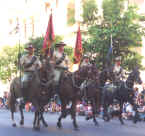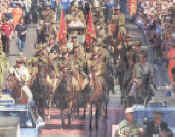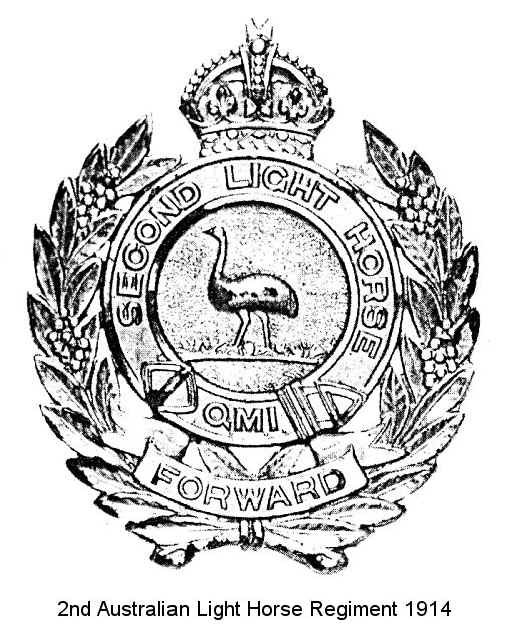 |
|
|
|
 |
2/14th Queensland Mounted Infantry |
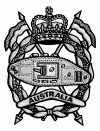 |
|
LINEAGE...also see CMF Light Horse for detailed lineage |
|
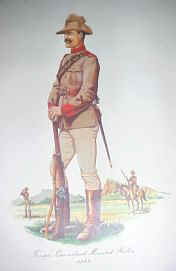 |
Trooper, Queensland Mounted Rifles 1893 |
|
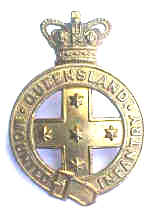 |
In 1891 the Shearers Strike occurred in Queensland and a State of Emergency
was declared. The Queensland Defence Force was called-out to re-establish and
maintain civil order and discipline. One of the units called-out was the Moreton
Mounted Infantry.
<< QMI Badge from Queen Victoria's reign. The troops were placed on full time duty for five months and served in the Barcaldine, Clermont, Longreach and Charleville districts. One of the Mounted Infantry officers who served at this time was Captain Harry George Chauvel - later to become General Sir Harry Chauvel. |
As the strike wore on the light horsemen found themselves deployed on patrol in western Queensland for weeks on end. To maintain their mounted skills they took to chasing the emus that abounded in the region. To prove their horsemanship the light horseman were required to ‘pluck’ the darker and smaller chest feathers of the emu while riding alongside it in full flight. The troopers would then place the feathers in the puggaree of their felt hats. When they returned home after the strike the Queensland Government allowed the Mounted Infantry to wear the emu plume in recognition of their service during the strike. At first it was solely a Queensland decoration, but in 1903 the privilege was extended to Tasmanian and South Australian regiments and finally, in 1915, to all the regiments of the Light Horse. It was also at this time that the emu was incorporated in the unit badge.
In 1897 the Mounted Infantry were reorganised as the Queensland Mounted Infantry consisting of 11 companies. By 1901 the Queensland Mounted Infantry had been organised as a Brigade of four Battalions of some 20 companies with a strength of 1200 officers and men. On the 10th July 1899 the Premier of Queensland, the Honourable J.R. Dickson, offered troops to help Great Britain against the Boers in South Africa. This was the first offer of assistance made by any of the Australian Colonies. It was accepted and one company of Mounted Infantry was detailed for duty. In October 1899, the 1st Contingent of the Queensland Mounted Infantry (QMI) enlisted, outfitted and trained for service in the Boer War in South Africa.
On the 28th of October 1899, the QMI marched through the City of Brisbane before departing for the War on the 1st of November 1899. On new year’s day 1900, a number of four man horse mounted reconnaissance patrols were scouting to the front and flanks of the main body to prevent an enemy ambush. Lieutenant Aide led one of these patrols consisting of Privates Herman, Butler, Rose and Jones. While riding along in open country, the patrol saw four Boers riding on their right. As Lieutenant Aide audaciously ordered the Boers to surrender twelve more enemy soldiers appeared and opened fire. Private Victor Jones was shot and died instantly. Lieutenant Aide was shot twice and his horse killed from under him. As the rest of the patrol came to his rescue, the Boers wounded another soldier and killed his horse. The small patrol struggled back to the main body in time to join the attack that was to become known as the Battle of Sunnyside. Amazingly, they had prevented a Boer encirclement. The major significance of this event is that Private V.S. Jones and Private D.C. McLeod, killed in Battle of Sunnyside, were the first Australian soldiers to die in battle.
In the period following the Boer War the State forces were amalgamated to form the Commonwealth Military Forces. In the changes the four battalions of the QMI were reformed as the 13th, 14th and 15th Australian Light Horse Regiments (Queensland Mounted Infantry).
King Edward VII awarded a King's Banner to each unit that served in the South African War and in 1904 each of the three Regiments of the QMI was represented in Melbourne where the Governor-General presented the banners. In 1908 each regiment was further awarded the Battle Honour
- South Africa 1899-1900-1-2.
With the introduction of compulsory military service the army was expanded and in 1912 the designation of the units of the QMI were again changed to 1st, 2nd, 3rd and 27th Light Horse Regiments (QMI). During World War 1 these units continued to serve at home and in 1914 a volunteer expeditionary force, the Australian Imperial Force, was formed. The 2nd ALH served at Anzac on the Gallipoli Peninsula where it distinguished itself at Quinn's Post, Sari Bair and Suvla and later served in Egypt, Palestine and Syria.
Some of the actions in which the Regiment took part included Romani, Charge of Magdhaba, Rafa, Gaza, Beersheba, Jerusalem, Megiddo and Jordan.
A significant event in the unit’s history is the battle of Beersheba. This battle is well known due to the movie known as "The Lighthorsemen". On the 31st of October 1917, the unit played an important role in what has been commonly referred to "as the last great cavalry charge in history". Turkish forces were defending the town of Beersheba with heavy fortifications and prepared positions. The town itself contained water wells that were crucial for the continuation of the operation. Indeed, many of the horses had not been watered for twenty-four to forty-eight hours before the attack. If the town was not captured before sunset the Light Horse would have to turn back and seek water elsewhere. Having determined that the south western approach to Beersheba had the least opposition, General Harry Chauvel decided that he could not employ the normal Light Horse tactic of deploying on horseback, dismounting and attacking on foot. Chauvel decided the only path to success was with a full-blooded mounted charge. Amazingly, the Light Horse managed to overwhelm the Turkish defences resulting in the capture of the town.
In July 1918 the 1st ANZAC Battalion of the Imperial Camel Corps, which had fought with the Desert Mounted Corps, became the 14th Australian Light Horse Regiment. They took part in the final offensive which overthrew the Turkish right flank in Palestine.
On the 17th of August 1918 the units of the QMI underwent another change. The 1st, 3rd and 27th Light Horse Regiments became the 5th, 11th and 14th Light Horse Regiments (QMI).
In 1930 as an economy measure, compulsory military service was abolished and the CMF reverted to voluntary service. As a result, 2nd Moreton Light Horse (QMI) and the 14th West Moreton Light Horse (QMI) were linked to form 2nd/14th Light Horse Regiment (QMI).
On the outbreak of World War II in 1939 the serving units of QMI were 2nd/14th, 5th and 11th Light Horse Regiments forming the 1st Cavalry Brigade. In August 1940 the 2nd/14th Light Horse Regiment was unlinked and the 14th was raised in Eastern Command as 14th Light Horse (MG) Regiment. 14th Light Horse (MG) Regiment became 14th Motor Regiment in March 1942 and was disbanded in May 1942. The troops were sent to 2nd/4th Armoured Regiment and 3 Army Tank Brigade.
2nd Moreton Light Horse (QMI) changed its name several times to eventually become 2nd Australian Cavalry Regiment (AIF) and was finally disbanded in Townsville on 29th July, 1943.
In 1948, CMF units were again raised but with no armoured unit allocated to Queensland. On 20th July 1949, A Squadron 2nd/14th QMI was raised as an armoured car squadron. Eighteen months later the unit was increased to regimental strength and was equipped with Staghound Armoured Cars, Canadian Scout Cars and White Armoured Personnel Carriers. On 6th August 1950 at Kelvin Grove Barracks, a mounted party of pre-war members handed over the guidons of the 2nd and 14th Light Horse Regiments to the unit.
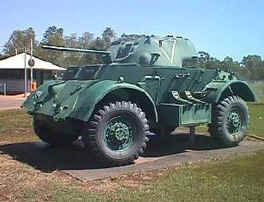 |
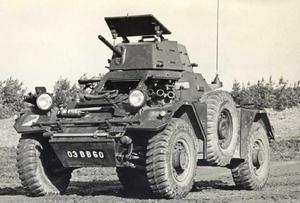 |
| Staghound Armoured Car | Ferret Armoured Car |
During 1952 the regiment was changed to a heavy tank unit however it continued to train with the same equipment. In 1956 the role changed to anti-tank. Initially the unit was equipped with 6 pounder and 17 pounder guns but these were soon replaced, firstly by 120mm (BAT) anti-tank guns and finally by 106mm Recoilless Rifles.
In 1960 the reorganisation of the Army resulted in the closure of the QMI country depots. A Squadron became a regular army squadron and eventually became B Squadron 1st Cavalry Regiment.
During 1966 2nd/14th QMI was once again designated a Cavalry Regiment and re-equipped with Staghound Armoured Cars, Ferret Scout Cars and Saracen Armoured Personnel Carriers. The Regiment was reduced to a squadron on 31st July 1976 and continued to train in the cavalry role using vehicles of the M113A1 family. 21st February 1980 saw the arrival of the first Fire Support Vehicle (Scorpion) mounting a 76mm gun.
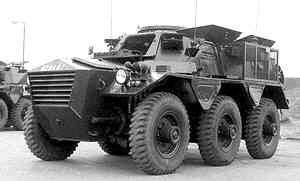 |
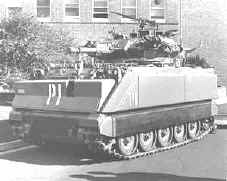 |
On 2nd December 1980 the unit again became a Regiment and on 31st October 1981 was renamed 2nd/14th Light Horse Regiment (Queensland Mounted Infantry). On the 29th of June 1986 the Regiment became an integrated regular army and army reserve unit with the role of providing an Armoured Personnel Carrier lift capability for the 6th Brigade in Enoggera. In July 1997 the role of the regiment was changed to that of conducting armoured reconnaissance. The Light Horse Regiment is equipped with the M113 Light Reconnaissance Vehicle which will be replaced by the Australian Light Armoured Vehicle (ASLAV) in 2001-2004. The new vehicle is specifically designed to conduct reconnaissance, which will significantly enhance the capability of the unit.
